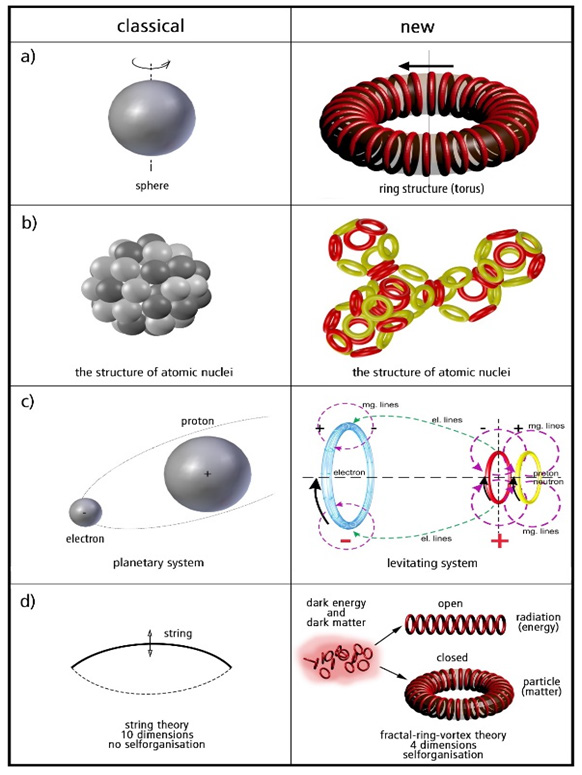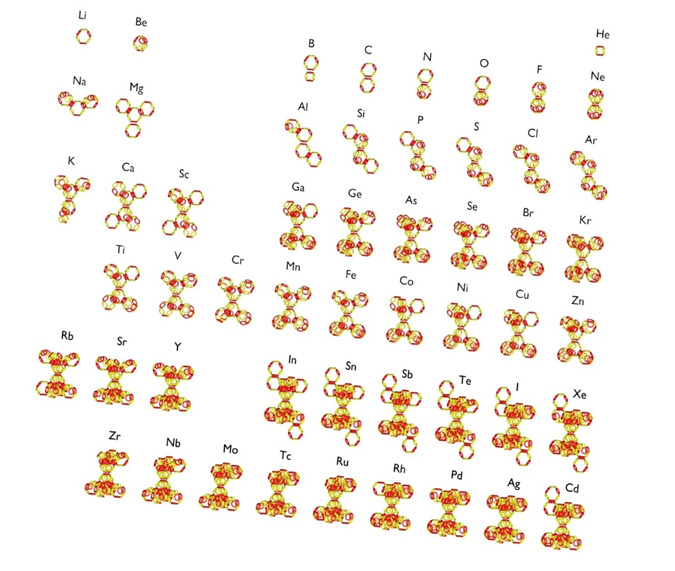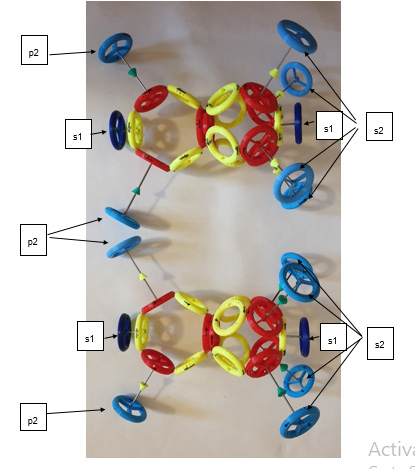Review Article 
 Creative Commons, CC-BY
Creative Commons, CC-BY
New Ring Models of Atoms and Molecules
*Corresponding author: Pavel Osmera, Czech Republic, Mechanical Department, Brno University of Technology, retired university professor, Czech Republic.
Received: October 10, 2023; Published: November 14, 2023
DOI: 10.34297/AJBSR.2023.20.002729
Abstract
Using the ring model of atoms and molecules, was revealed that there must be two types (type A and type B) of atoms that differ in the direction of rotation of individual rings (for type B, all rings rotate opposite to the directions of rotation for type A) but have the same structure. The rotations of protons and neutrons in atoms are given by a system that resembles a “cogwheel” in gear box. Both types A and B have the same structure. Solution to this problem was found in the design of the TiO2 model, which has a total of 22 protons, 22 electrons and 26 neutrons in titanium atom (Ti). Each oxygen atom has 8 protons, 8 electrons and 8 neutrons.
Keywords: Ring model, Direction of rotation of proton, Neutron and electron, Directions of magnetic moments, photocatalytic cleaner with TiO2, Graphene, Photocatalysis, Titanium dioxide TiO2, UV light
Introduction
The classical approach in particle physics is based on the fact that the electron has some parameters like charge, mass, etc. but does not have a structure. The electron is calculated as a point particle having magnetic properties. Combining knowledge of physical chemistry [1-3]. Evolutionary optimization, 3D graphics, programming in Python, and mathematics make it possible to create1 programs for designing new nanostructure models. The first testing proposal for the nanostructure prediction program is limited to carbon structures. On Figure 1 are classical and new models of Nature. Theory VFRT (Vortex Fractal Ring Theory) uses the electron, proton, and neutron as the particle with a toroidal (ring) shape, which is formed by fractal substructures [4]. connected to each other by vortex electromagnetic fields. The atomic nucleus can be built from ring protons and neutrons. Combining knowledge of atomic nucleus structures and evolutionary optimization makes it possible to create programs for designing new nanostructure models. The first testing proposal for the nanostructure prediction program was limited to carbon structures. The aim was to verify whether the proposed program is capable of generating known carbon na nostructures, such as graphene. The following versions of the program will no longer have this limitation. The air cleaner uses familiar principles but in an unconventional original way. The surface with titanium dioxide TiO2 is activated by UV light (a wavelength of 365 nm - band A with the maximum photocatalysis efficiency). The air flow is done by 2 fans that have an adjustable speed. Photocatalysis breaks down viruses (including coronavirus and all its current and future mutations) into harmless atoms and molecules. The activated surface of titanium dioxide (TiO2) removes binding electrons from the structures. UV light with a wavelength of about 365nm (band A) is used to activate the photocatalytic surface, in contrast to hard radiation with a wavelength of about 200nm (band C). Hard radiation kills living structures but does not break down into simpler structures. We use UV light generated by UV. The advantage of UV LEDs is that a low and safe DC supply voltage of 12 or 24V can be used. We can only hope that this principle will help slow down or stop the spread of viral diseases. Photocatalysis also decomposes harmful bacteria, fungi, unpleasant odors, cigarette smoke and chimney smoke, and harmful gases from cars and motorcycles (Figure 1).
Ring Structures of Atom Nuclei
The nucleus of an atom consists of substructures (globules in Figure 2) [5-7]. E.g., the atomic nucleus of oxygen is in Figure 4 (Figure 2).
Combination of substructures from Figure 2 we can create all nuclei of Periodic Table (see Figure 3where nuclei from Helium to Xenon) are (Figure 3).

Figure 2: Substructures of nuclei can be created from five types of globules, where protons are red rings and neutrons are yellow rings.
The rotations of protons and neutrons in atoms are given by a system that resembles a “cogwheel” in gear box. Both types A and B have the same structure. Solution to this problem was found in the design of the TiO2 model, which has a total of 22 protons, 22 electrons and 26 neutrons in titanium atom (Ti). Each oxygen atom has 8 protons, 8 electrons and 8 neutrons. The TiO2 model therefore consists of 118 rings (protons, neutrons and electrons). Two types of electrons are distinguished in the model (valence electrons are colored light blue and inner electrons are colored dark blue). The direction of rotation of the proton determines the direction of the magnetic moment that exits the atom. For an external view of the proton, it has (for clockwise rotation of the proton) the proton has a magnetic moment that exits the proton (yellow arrow). For counterclockwise rotation of the proton) the proton has a magnetic moment that enters the proton (green arrow). For example, in the case of an oxygen molecule O2, oxygen atoms of type A and type B are joined. The magnetic moments in the binding of two protons must follow the same direction. Only the magnetic moment with the yellow arrow can be combined with the magnetic moment with the green arrow (Figure 4).
Name of Electrons Inside Atom of Oxygen (Type A And Type B)
(Figure 5)
Example of Application
(Figure 6)
Conclusion
All atoms exist in two types (type A and B). They have the same structure but have opposite magnetic moments.
It is certainly less dangerous to break down viruses and bacteria into harmless molecules than to be vaccinated, for example, against coronavirus. It is not known what long-term negative consequences vaccination will have on some organs of the human body. Because the covid-19 virus is constantly mutating, there may be situations where previous vaccinations will have no protection and hospital staff may also be infected. Then there will be no one who can help seriously ill patients. There would be a collapse in health care. Another big problem is that some people don’t want to be vaccinated. For such people, effective prevention is best. Therefore, the use of photocatalytic decomposition of viruses in hospitals and households, etc. is very effective as prevention. The described principle of photocatalytic air purification finds application in air conditioning units of buildings. There is no need so large number of separate air purifiers in each room.
Acknowledgement
None.
Conflict of Interest
None.
References
- Pauling L (1988) General Chemistry, Dover publication, Inc, New York.
- Ramsden EN (2000) A-Level Chemistry, Nelson Thornes Ltd, 4th
- Heyrovska R (2005) The golden ratio, ionic and atom radii bond lenth, Molecular Physics, ISSN0026-8976.
- Zmeskal O, Nezadal M, Buchnick M (2003) Fractal-Cantorial geometry, Hausdorf dimension and fundamental laws of physics, Chaos, Solit atom radii bond lenth ions and Fractals 17: 113-119.
- Werner P (2018) Základy modelování prstencové struktury elementárních částic hmoty, Ústav teoretické a experimentální elelektrotechniky, Brno ISBN 978-80-214-5620-4.
- Osmera P (2010) Vortex-ring-fractal Structure of Atom and Molecule, in the book IAENG Transaction on Engineering Technologies, American Institute of Physics 4: 313-327.
- More about VFRT theory can be found on http://www.pavelosmera.cz/public/public.html








 We use cookies to ensure you get the best experience on our website.
We use cookies to ensure you get the best experience on our website.